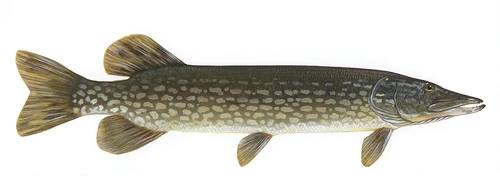Information
Author: María J. Cabrera-Álvarez
Version: C | 1.1Published: 2024-12-31
- minor editorial changes plus new side note "Commercial relevance"
no information available
WelfareScore | farm
The score card gives our welfare assessments for aquatic species in 10 criteria.
For each criterion, we score the probability to experience good welfare under minimal farming conditions ("Likelihood") and under high-standard farming conditions ("Potential") representing the worst and best case scenario. The third dimension scores how certain we are of our assessments based on the number and quality of sources we found ("Certainty").
The WelfareScore sums just the "High" scores in each dimension. Although good welfare ("High") seems not possible in some criteria, there could be at least a potential improvement from low to medium welfare (indicated by ➚ and the number of criteria).
- Li = Likelihood that the individuals of the species experience good welfare under minimal farming conditions
- Po = Potential of the individuals of the species to experience good welfare under high-standard farming conditions
➚ = potential improvements not reaching "High" - Ce = Certainty of our findings in Likelihood and Potential
WelfareScore = Sum of criteria scoring "High" (max. 10 per dimension)
General remarks
Esox lucius is a voracious predator that inhabits freshwater streams and lakes of most of the northern hemisphere (i.e., North America, north of Europe, and north of Asia). E. lucius' cannibalistic nature since early stages makes it unsuitable for intensive farming because survival is low even with plenty of food, and the use of live prey (sometimes in polyculture systems) increases production costs. LARVAE and FINGERLINGS are primarily produced for stocking of natural populations, with an optimal harvest size of 7-10 cm (2-5 g) or 4-6 cm to avoid cannibalism. A second use is as predator in polyculture pond systems to suppress commercially less valuable cyprinid species to benefit Cyprinus carpio. Reproduction in captivity is achieved in conditions similar to natural ones as well as with hormonal induction of maturation. Although E. lucius only migrates to spawning grounds, its use of space can be quite large, therefore captive conditions will negatively impact its welfare. Additionally, E. lucius is stressed when in captive conditions and when handled, suffers from malformations both in captivity and in the wild, and there is no stunning and slaughter method implemented specifically for it. All these facts make of E. lucius an undesirable candidate for aquaculture.
1 Home range
Many species traverse in a limited horizontal space (even if just for a certain period of time per year); the home range may be described as a species' understanding of its environment (i.e., its cognitive map) for the most important resources it needs access to.
What is the probability of providing the species' whole home range in captivity?
It is low for minimal farming conditions, as tanks, cages, and some ponds do not cover the whole range in the wild. It is medium for high-standard farming conditions, as other ponds at least overlap with the range in the wild, although we cannot be sure in most age classes. Our conclusion is based on a medium amount of evidence, as wild information in LARVAE, FRY, JUVENILES, and SPAWNERS is missing.


2 Depth range
Given the availability of resources (food, shelter) or the need to avoid predators, species spend their time within a certain depth range.
What is the probability of providing the species' whole depth range in captivity?
It is low for minimal farming conditions, as tanks, RAS, and some ponds do not cover the whole range in the wild. It is medium for high-standard farming conditions, as other ponds at least overlap with the range in the wild. Our conclusion is based on a medium amount of evidence, as further information is needed on farms.


3 Migration
Some species undergo seasonal changes of environments for different purposes (feeding, spawning, etc.), and to move there, they migrate for more or less extensive distances.
What is the probability of providing farming conditions that are compatible with the migrating or habitat-changing behaviour of the species?
It is low for minimal farming conditions, as the species undertakes more or less extensive migrations, and we cannot be sure that providing each age class with their respective environmental conditions will satisfy their urge to migrate or whether they need to experience the transition. It is medium for high-standard farming conditions, as the range in captivity overlaps with the migration distance. Our conclusion is based on a medium amount of evidence.


4 Reproduction
A species reproduces at a certain age, season, and sex ratio and possibly involving courtship rituals.
What is the probability of the species reproducing naturally in captivity without manipulation of these circumstances?
It is low for minimal farming conditions, as the species is manipulated (photoperiod and hormonal manipulation, stripping) and may be taken from the wild. It is high for high-standard farming conditions, as natural maturation and natural spawning is possible and verified for the farming context. Our conclusion is based on a medium amount of evidence.


5 Aggregation
Species differ in the way they co-exist with conspecifics or other species from being solitary to aggregating unstructured, casually roaming in shoals or closely coordinating in schools of varying densities.
What is the probability of providing farming conditions that are compatible with the aggregation behaviour of the species?
It is low for minimal and high-standard farming conditions, as – even in the absence of density data in the wild or in farms – we may conclude from the fact that the species is solitary that densities in tanks, RAS, and ponds are potentially stress inducing. Our conclusion is based on a low amount of evidence, as further information is needed for LARVAE, FRY, ADULTS, and SPAWNERS.


6 Aggression
There is a range of adverse reactions in species, spanning from being relatively indifferent towards others to defending valuable resources (e.g., food, territory, mates) to actively attacking opponents.
What is the probability of the species being non-aggressive and non-territorial in captivity?
It is low for minimal and high-standard farming conditions, as the species is aggressive – even cannibalistic – in almost all age classes and as ways to reduce cannibalism come with caveats: providing live prey is welfare-reducing for the prey species, and decreasing density to a very low level has only been done in restocking. Our conclusion is based on a high amount of evidence.


7 Substrate
Depending on where in the water column the species lives, it differs in interacting with or relying on various substrates for feeding or covering purposes (e.g., plants, rocks and stones, sand and mud, turbidity).
What is the probability of providing the species' substrate and shelter needs in captivity?
It is low for minimal farming conditions, as the species uses substrate, but a) incubation bottles, net cages, tanks, and RAS are devoid of it and b) given stripping in SPAWNERS. It is high for high-standard farming conditions given ponds with vegetation for all age classes (including natural reproduction for SPAWNERS). Our conclusion is based on a high amount of evidence.


8 Stress
Farming involves subjecting the species to diverse procedures (e.g., handling, air exposure, short-term confinement, short-term crowding, transport), sudden parameter changes or repeated disturbances (e.g., husbandry, size-grading).
What is the probability of the species not being stressed?
It is unclear for minimal and high-standard farming conditions, given we just found data on ADULTS. Our conclusion is based on a low amount of evidence, as further research is needed on all other age classes.


9 Malformations
Deformities that – in contrast to diseases – are commonly irreversible may indicate sub-optimal rearing conditions (e.g., mechanical stress during hatching and rearing, environmental factors unless mentioned in crit. 3, aquatic pollutants, nutritional deficiencies) or a general incompatibility of the species with being farmed.
What is the probability of the species being malformed rarely?
It is low for minimal farming conditions, as malformation rates may exceed 10%. It is medium for high-standard farming conditions, as some malformations result from conditions that may be changed (storing, incubation temperature, duration in RAS, suspended solids). Our conclusion is based on a medium amount of evidence, as improvement of the situation by adjusting conditions needs more proof.


10 Slaughter
The cornerstone for a humane treatment is that slaughter a) immediately follows stunning (i.e., while the individual is unconscious), b) happens according to a clear and reproducible set of instructions verified under farming conditions, and c) avoids pain, suffering, and distress.
What is the probability of the species being slaughtered according to a humane slaughter protocol?
It is unclear for minimal and high-standard farming conditions, although percussive stunning seems promising, but needs to be verified for the farming context. Our conclusion is based on a low amount of evidence.


Side note: Domestication
Teletchea and Fontaine introduced 5 domestication levels illustrating how far species are from having their life cycle closed in captivity without wild input, how long they have been reared in captivity, and whether breeding programmes are in place.
What is the species’ domestication level?
DOMESTICATION LEVEL 4 50, level 5 being fully domesticated.
Side note: Forage fish in the feed
450-1,000 milliard wild-caught fishes end up being processed into fish meal and fish oil each year which contributes to overfishing and represents enormous suffering. There is a broad range of feeding types within species reared in captivity.
To what degree may fish meal and fish oil based on forage fish be replaced by non-forage fishery components (e.g., poultry blood meal) or sustainable sources (e.g., soybean cake)?
All age classes:
- WILD: carnivorous (mostly fish, but also invertebrates) 16 19 30.
- FARM: preference for live prey over granulated feed 5.
- LAB: no data found yet.
Side note: Commercial relevance
How much is this species farmed annually?
1,494 t in 2022 51.
Glossary
DOMESTICATION LEVEL 4 = entire life cycle closed in captivity without wild inputs 50
FARM = setting in farming environment or under conditions simulating farming environment in terms of size of facility or number of individuals
FINGERLINGS = early juveniles with fully developed scales and working fins, the size of a human finger
FRY = larvae from external feeding on
IND = individuals
JUVENILES = fully developed but immature individuals
LAB = setting in laboratory environment
LARVAE = hatching to mouth opening
PHOTOPERIOD = duration of daylight
POTAMODROMOUS = migrating within fresh water
RAS = Recirculating Aquaculture System - almost completely closed system using filters to clean and recirculate water with the aim of reducing water input and with the advantage of enabling close control of environmental parameters to maintain high water quality
SPAWNERS = adults during the spawning season; in farms: adults that are kept as broodstock
TOTAL LENGTH = from snout to tip of caudal fin as compared to fork length (which measures from snout to fork of caudal fin) or standard length (from head to base of tail fin) or body length (from the base of the eye notch to the posterior end of the telson) 34
WILD = setting in the wild
Bibliography
2 Sutela, T., P. Korhonen, and K. Nyberg. 2004. Stocking success of newly hatched pike evaluated by radioactive strontium (85Sr) marking. Journal of Fish Biology 64: 653–664. https://doi.org/10.1111/j.1095-8649.2004.00329.x.
3 Horvath, L., G. Tamas, and C. Seagrave. 2002. Carp and Pond Fish Culture: Including Chinese Herbivorous Species, Pike, Tench, Zander, Wels Catfish, Goldfish, African Catfish and Sterlet. 2nd Edition.
4 Kuparinen, Anna, and Hannu Lehtonen. 2018. Northern Pike Commercial Fisheries, Stock Assessment and Aquaculture. In Biology and Ecology of Pike, ed. Christian Skov and P. Anders Nilsson, 1st ed., 123–163. Boca Raton, FL : CRC Press, 2017. | “A Science Publishers book.”: CRC Press. https://doi.org/10.1201/9781315119076-8.
5 Szczepkowski, Mirosław, Zdzisław Zakęś, Andrzej Kapusta, Bożena Szczepkowska, Marek Hopko, Sylwia Jarmołowicz, Agata Kowalska, et al. 2012. Growth and survival in earthen ponds of different sizes of juvenile pike reared in recirculating aquaculture systems. Archives of Polish Fisheries 20. https://doi.org/10.2478/v10086-012-0030-2.
6 Carbine, William F. 1945. Growth potential of the northern pike (Esox lucius). éditeur non identifié.
7 Raat, Alexander J. P. 1988. Synopsis of Biological Data on the Northern Pike: Esox Lucius Linnaeus, 1758. Vol. 2. FAO Fisheries Synopsis 30. Food and Agriculture Organization of the United Nations.
8 Chapman, C. A., and W. C. Mackay. 1984. Versatility in habitat use by a top aquatic predator, Esox lucius L. Journal of Fish Biology 25: 109–115. https://doi.org/10.1111/j.1095-8649.1984.tb04855.x.
9 Diana, James S., W. C. Mackay, and Mark Ehrman. 1977. Movements and Habitat Preference of Northern Pike (Esox lucius) in Lac Ste. Anne, Alberta. Transactions of the American Fisheries Society 106: 560–565. https://doi.org/10.1577/1548-8659(1977)106<560:MAHPON>2.0.CO;2.
10 Bondarenko, V, J Křišťan, V Švinger, and T Policar. 2013. Reproduction and rearing of advanced northern pike (Esox lucius L.) fry. Vodnany 144.
11 Casselman, John M, and Cheryl A Lewis. 1996. Habitat requirements of northern pike 53.
12 Frost, Winifred E., and Charlotte Kipling. 1967. A Study of Reproduction, Early Life, Weight-Length Relationship and Growth of Pike, Esox lucius L., in Windermere. The Journal of Animal Ecology 36: 651. https://doi.org/10.2307/2820.
13 Clark, Clarence F. 1950. Observations on the Spawning Habits of the Northern Pike, Esox lucius, in Northwestern Ohio. Copeia 1950: 285. https://doi.org/10.2307/1437909.
14 Alldridge, N. A., and A. M. White. 1980. Spawning site preferences for northern pike (Esox lucius) in a New York marsh with widely fluctuating water levels. Ohio J. Sci 80: 57–73.
15 Tibblin, Petter, Anders Forsman, Tobias Borger, and Per Larsson. 2016. Causes and consequences of repeatability, flexibility and individual fine-tuning of migratory timing in pike. Journal of Animal Ecology 85: 136–145. https://doi.org/10.1111/1365-2656.12439.
16 Franklin, Donald R., and Lloyd L. Smith. 1963. Early Life History of the Northern Pike, Esox lucius L., with Special Reference to the Factors Influencing the Numerical Strength of Year Classes. Transactions of the American Fisheries Society 92: 91–110. https://doi.org/10.1577/1548-8659(1963)92[91:ELHOTN]2.0.CO;2.
17 Cabrera-Álvarez, María. 2023. Conclusion.
18 Soivio, Antti, and Aimo Oikari. 1976. Haematological effects of stress on a teleost, Esox lucius L. Journal of Fish Biology 8: 397–411. https://doi.org/10.1111/j.1095-8649.1976.tb03968.x.
19 Bregazzi, P. R., and C. R. Kennedy. 1980. The biology of pike, Esox lucius L., in a southern eutrophic lake. Journal of Fish Biology 17: 91–112. https://doi.org/10.1111/j.1095-8649.1980.tb02745.x.
20 Fabricius, Eric, and Karl-Jacob Gustafson. 1958. Some new observations on the spawning behaviour of the pike, Esox lucius L. L. Rep. Inst. Freshwater Res. Drottningholm 39: 2354.
21 Helfrich, Louis A, D J Orth, and R J Neves. 2009. Freshwater Fish Farming in Virginia: Selecting the Right Fish to Raise. Virginia Cooperative Extension 420–010.
22 Billard, Roland. 1996. Reproduction of pike: gametogenesis, gamete biology and early development. In Pike - Biology and exploitation, ed. Craig, 13–67.
23 Bilio, Martin. 2007. Controlled reproduction and domestication in aquaculture. Aquaculture Europe 32.
24 Bry, C., J. F. Batisse, and G. Neveu. 1989. Survival of pike (Esox lucius L.) broodstock in relation to type of reproduction. Aquaculture 83: 387–395. https://doi.org/10.1016/0044-8486(89)90049-5.
25 Bondarenko, V., Peter Podhorec, V. Švinger, and T. Policar. 2012. Effect of different spawning time on fertilization, hatching rate and embryo quality in northern pike, Esox lucius (L.). In Domestication in Finfish Aquaculture, Book of Abstracts.
26 Korhonen, P. 1995. Säännöstelykäytännön muutoksen vaikutukset Kymijoen Pyhäjärven haukikantoihin–Vesi-ja ympäristöhallituksen monistesarja, 640. Search in.
27 Holčík, J. 1968. Life history of the pike–Esox lucius Linnaeus, 1758, in the Klĭčava reservoir. Acta Societatis Zoologicae Bohemoslovacae.
28 Bry, Christian, Edgar Basset, Xavier Rognon, and François Bonamy. 1992. Analysis of sibling cannibalism among pike, Esox lucius, juveniles reared under semi-natural conditions. Environmental Biology of Fishes 35: 75–84. https://doi.org/10.1007/BF00001160.
29 Skov, C., L. Jacobsen, and S. Berg. 2003. Post-stocking survival of 0+ year pike in ponds as a function of water transparency, habitat complexity, prey availability and size heterogeneity. Journal of Fish Biology 62: 311–322. https://doi.org/10.1046/j.1095-8649.2003.00023.x.
30 Bry, C., F. Bonamy, J. Manelphe, and B. Duranthon. 1995. Early life characteristics of pike, Esox lucius, in rearing ponds: temporal survival pattern and ontogenetic diet shifts. Journal of Fish Biology 46: 99–113. https://doi.org/10.1111/j.1095-8649.1995.tb05949.x.
31 Stickney, R. R. 1986. Culture of Non Salmonid Freshwater Fishes. CRC Press, Inc. United States.
32 Bardach, J. E., J.H. Ryther, and W. O. McLamey. 1972. Aquaculture: The farming and husbandly of freshwater and marine organisms. Wiley-Interscience, New York.
33 Scott, W. B., and E. J. Crossman. 1973. Freshwater fishes of Canada. Bulletin ; No. 184 184. Ottawa: Fisheries Research Board of Canada.
34 Pawson, M.G., and G.D. Pickett. 1996. The Annual Pattern of Condition and Maturity in Bass, Dicentrarchus Labrax, in Waters Around England and Wales. Journal of the Marine Biological Association of the United Kingdom 76: 107. https://doi.org/10.1017/S0025315400029040.
35 Schwalme, K., and W. C. Mackay. 1985. The influence of exercise–handling stress on blood lactate, acid–base, and plasma glucose status of northern pike ( Esox lucius L.). Canadian Journal of Zoology 63: 1125–1129. https://doi.org/10.1139/z85-170.
36 Oikari, Aimo, and Antti Soivio. 1975. Influence of sampling methods and anaesthetization on various haematological parameters of several teleosts. Aquaculture 6: 171–180. https://doi.org/10.1016/0044-8486(75)90068-X.
37 Schwalme, K., and W. C. Mackay. 1985. The influence of angling-induced exercise on the carbohydrate metabolism of northern pike (Esox lucius L.). Journal of Comparative Physiology B 156: 67–75. https://doi.org/10.1007/BF00692927.
38 Pullen, Christopher E., Kristen Hayes, Constance M. O’Connor, Robert Arlinghaus, Cory D. Suski, Jonathan D. Midwood, and Steven J. Cooke. 2017. Consequences of oral lure retention on the physiology and behaviour of adult northern pike (Esox lucius L.). Fisheries Research 186: 601–611. https://doi.org/10.1016/j.fishres.2016.03.026.
39 Łuczyński, Marek J., Joanna Nowosad, Joanna Łuczyńska, and Dariusz Kucharczyk. 2022. Effect of Application of Different Activation Media on Fertilization and Embryo Survival of Northern Pike, (Esox lucius) under Hatchery Conditions. Animals 12: 1022. https://doi.org/10.3390/ani12081022.
40 Samarin, Azin Mohagheghi, Miroslav Blecha, Mariia Uzhytchak, Dmytro Bytyutskyy, Daniel Zarski, Martin Flajshans, and Tomas Policar. 2016. Post-ovulatory and post-stripping oocyte ageing in northern pike, Esox lucius (Linnaeus, 1758), and its effect on egg viability rates and the occurrence of larval malformations and ploidy anomalies. Aquaculture 450: 431–438. https://doi.org/10.1016/j.aquaculture.2015.08.017.
41 Bonisławska, M., K. Formicki, I. Smaruj, and J. Szulc. 2011. Total suspended solids in surface waters versus embryonic development of pike (Esox lucius, L.). Electronic Journal of Polish Agricultural Universities 14.
42 Bondarenko, V., B. Drozd, and T. Policar. 2015. Effect of water temperature on egg incubation time and quality of newly hatched larvae of northern pike (Esox lucius L., 1758). Journal of Applied Ichthyology 31: 45–50. https://doi.org/10.1111/jai.12851.
43 Réalis-Doyelle, Emilie, Alain Pasquet, Pascal Fontaine, and Fabrice Teletchea. 2022. Effects of temperature on the survival and development of the early life stages of northern pike (Esox lucius). Knowledge & Management of Aquatic Ecosystems 423: 13. https://doi.org/10.1051/kmae/2022007.
44 Lawler, G. H. 1964. A northern pike, Esox lucius, with an accessory fin. Journal of the Fisheries Board of Canada 21: 1547–1547.
45 Lawler, G. H. 1966. A Second Record of an Accessory Fin on Esox lucius. Journal of the Fisheries Research Board of Canada 23: 1969–1969. https://doi.org/10.1139/f66-183.
46 Lawler, G. H. 1966. Pugheadedness in Perch, Perca flavescens , and Pike, Esox lucius , of Heming Lake, Manitoba. Journal of the Fisheries Research Board of Canada 23: 1807–1808. https://doi.org/10.1139/f66-167.
47 Skurdal, Jostein. 1981. A snub-nosed pike caught in lake Tyrifhorden. Fauna, Blindern 34: 87.
48 Hegemann, Manfred. 1964. Der Hecht:(Esox lucius L.). Ziemsen.
49 Quigley, D. T. G. 2015. Northern Pike Esox lucius L. with abnormal tri-lobed caudal fin. Bulletin-European Association of Fish Pathologists 35: 227–232.
50 Teletchea, Fabrice, and Pascal Fontaine. 2012. Levels of domestication in fish: implications for the sustainable future of aquaculture. Fish and Fisheries 15: 181–195. https://doi.org/10.1111/faf.12006.
51 FAO. 2024. FishStat: Global aquaculture production 1950-2022. www.fao.org/fishery/en/statistics/software/fishstatj: FishStatJ.
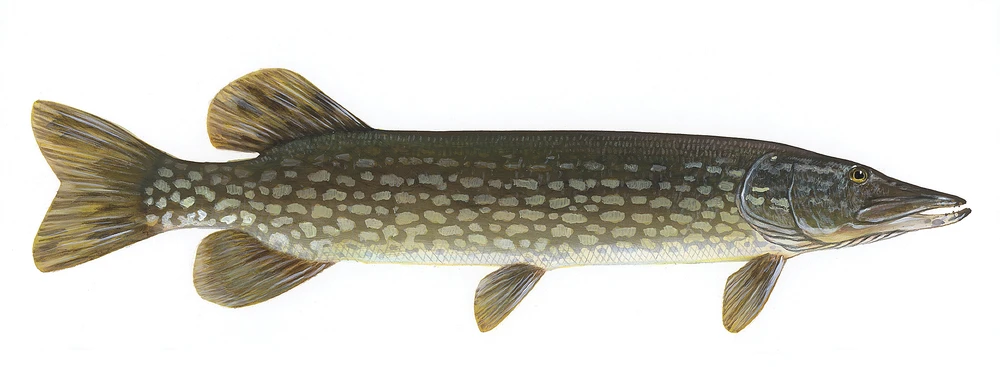
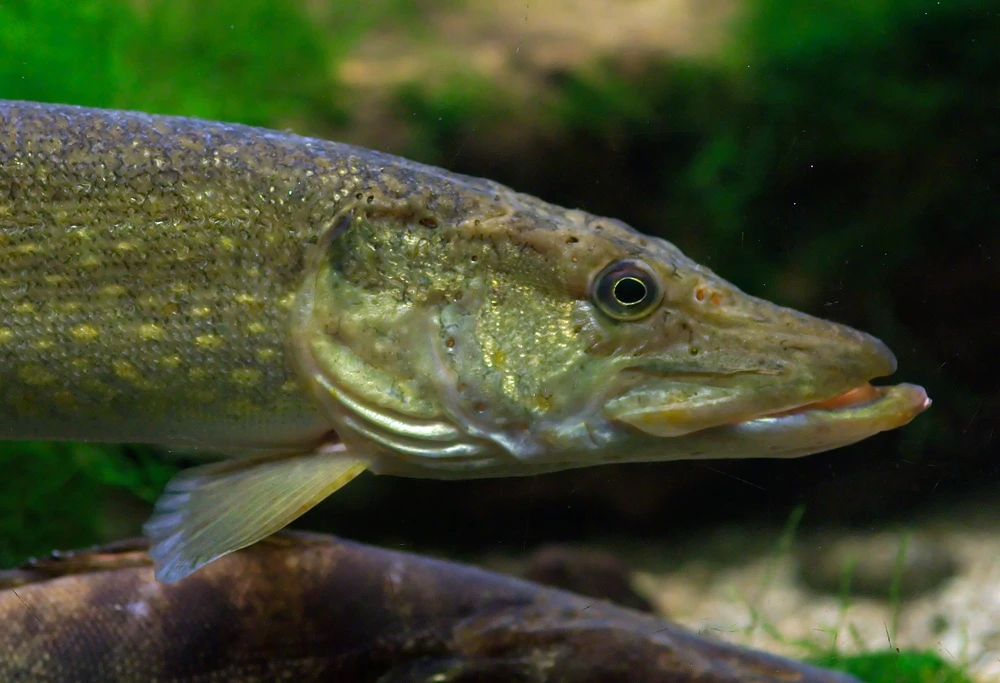
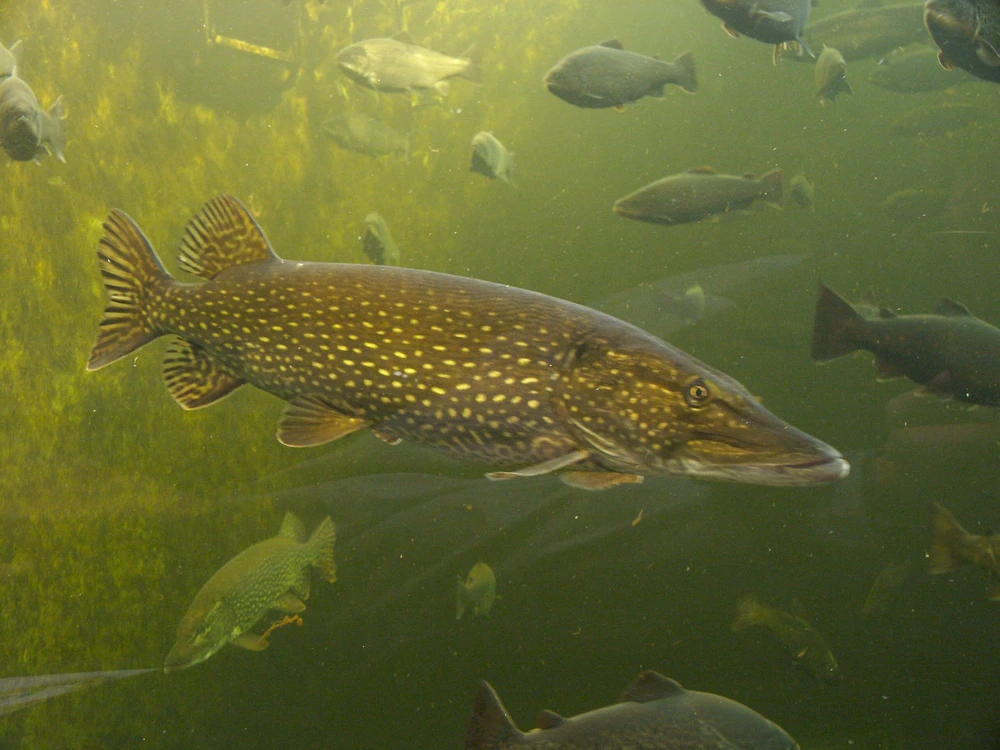
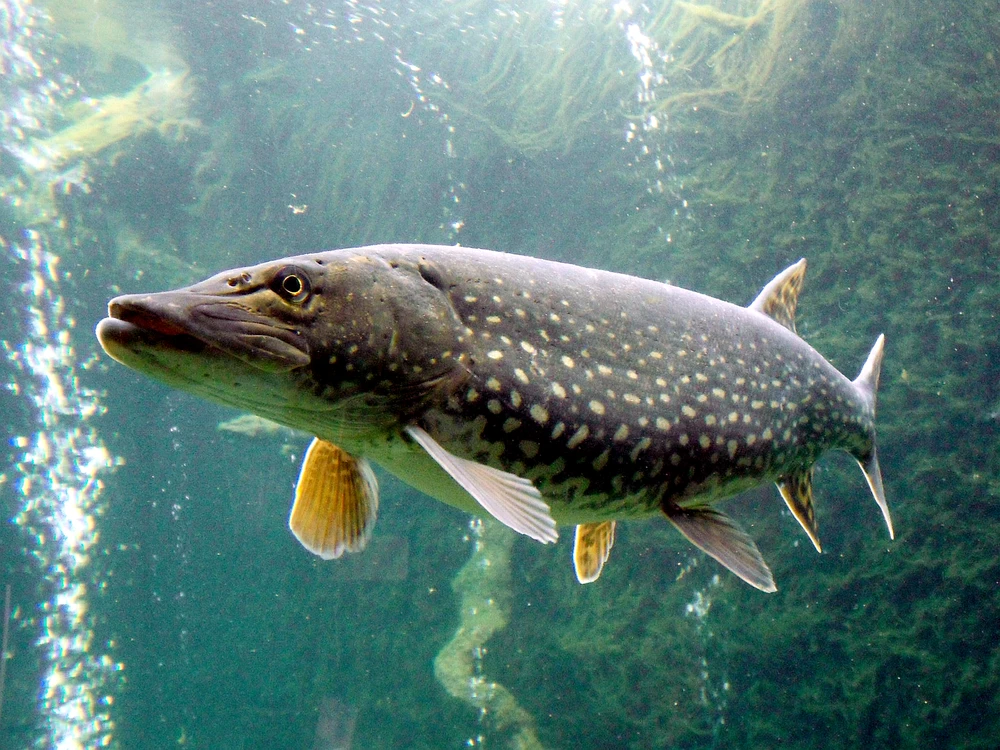
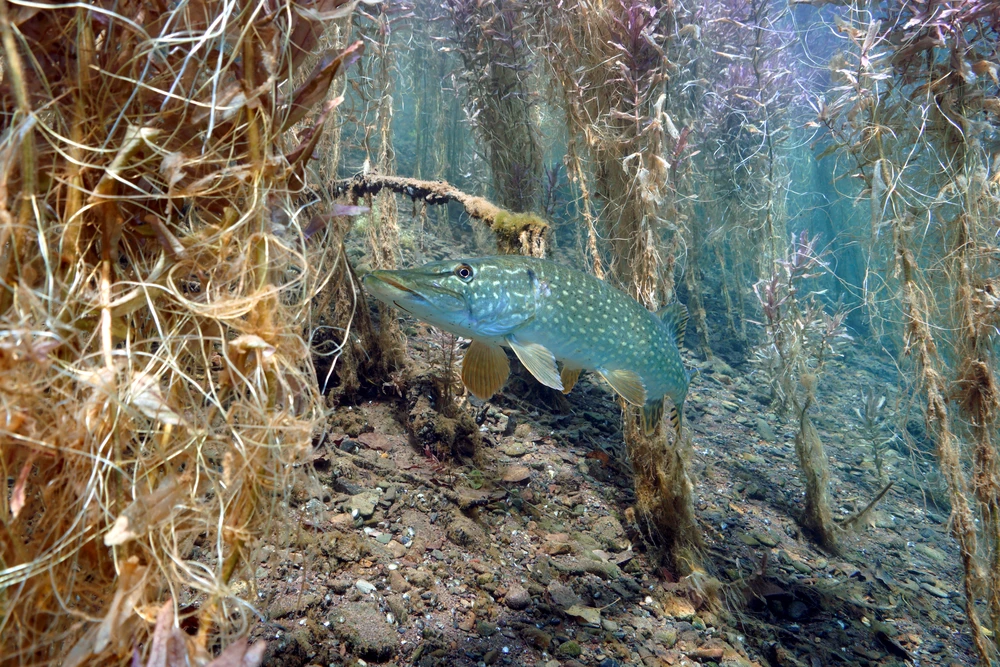
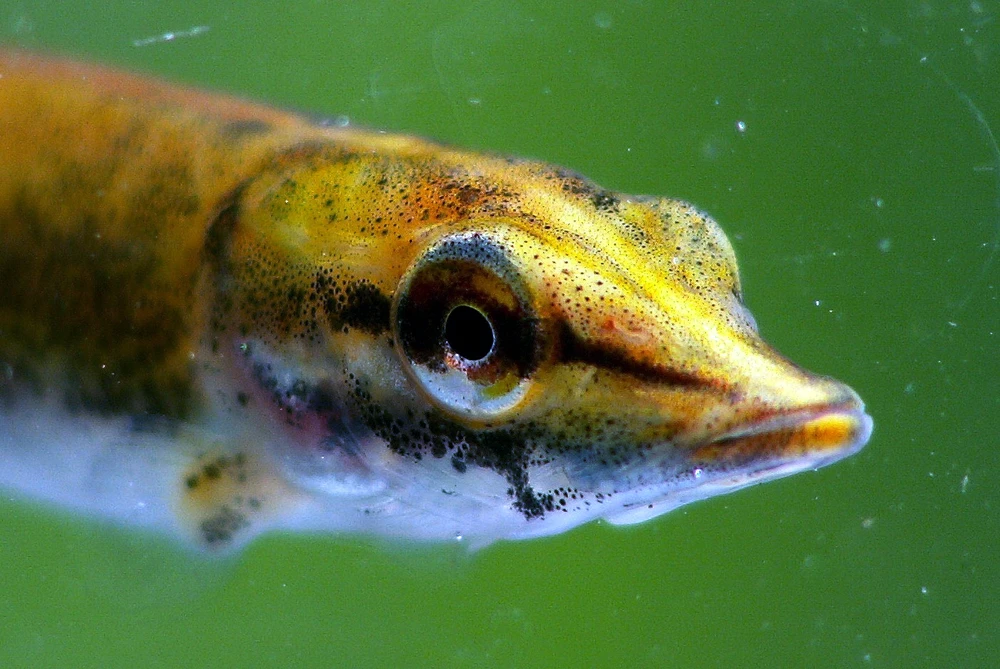






Lorem ipsum
Something along the lines of: we were aware of the importance of some topics so that we wanted to include them and collect data but not score them. For WelfareChecks | farm, these topics are "domestication level", "feed replacement", and "commercial relevance". The domestication and commercial relevance aspects allow us to analyse the questions whether increasing rate of domestication or relevance in farming worldwide goes hand in hand with better welfare; the feed replacement rather goes in the direction of added suffering for all those species which end up as feed. For a carnivorous species, to gain 1 kg of meat, you do not just kill this one individual but you have to take into account the meat that it was fed during its life in the form of fish meal and fish oil. In other words, carnivorous species (and to a degree also omnivorous ones) have a larger "fish in:fish out" ratio.
Lorem ipsum
Probably, we updated the profile. Check the version number in the head of the page. For more information on the version, see the FAQ about this. Why do we update profiles? Not just do we want to include new research that has come out, but we are continuously developing the database itself. For example, we changed the structure of entries in criteria or we added explanations for scores in the WelfareCheck | farm. And we are always refining our scoring rules.
The centre of the Overview is an array of criteria covering basic features and behaviours of the species. Each of this information comes from our literature search on the species. If we researched a full Dossier on the species, probably all criteria in the Overview will be covered and thus filled. This was our way to go when we first set up the database.
Because Dossiers are time consuming to research, we switched to focusing on WelfareChecks. These are much shorter profiles covering just 10 criteria we deemed important when it comes to behaviour and welfare in aquaculture (and lately fisheries, too). Also, WelfareChecks contain the assessment of the welfare potential of a species which has become the main feature of the fair-fish database over time. Because WelfareChecks do not cover as many criteria as a Dossier, we don't have the information to fill all blanks in the Overview, as this information is "not investigated by us yet".
Our long-term goal is to go back to researching Dossiers for all species covered in the fair-fish database once we set up WelfareChecks for each of them. If you would like to support us financially with this, please get in touch at ffdb@fair-fish.net
See the question "What does "not investigated by us yet" mean?". In short, if we have not had a look in the literature - or in other words, if we have not investigated a criterion - we cannot know the data. If we have already checked the literature on a criterion and could not find anything, it is "no data found yet". You spotted a "no data found yet" where you know data exists? Get in touch with us at ffdb@fair-fish.net!
Once you have clicked on "show details", the entry for a criterion will unfold and display the summarised information we collected from the scientific literature – complete with the reference(s).
As reference style we chose "Springer Humanities (numeric, brackets)" which presents itself in the database as a number in a grey box. Mouse over the box to see the reference; click on it to jump to the bibliography at the bottom of the page. But what does "[x]-[y]" refer to?
This is the way we mark secondary citations. In this case, we read reference "y", but not reference "x", and cite "x" as mentioned in "y". We try to avoid citing secondary references as best as possible and instead read the original source ourselves. Sometimes we have to resort to citing secondarily, though, when the original source is: a) very old or not (digitally) available for other reasons, b) in a language no one in the team understands. Seldomly, it also happens that we are running out of time on a profile and cannot afford to read the original. As mentioned, though, we try to avoid it, as citing mistakes may always happen (and we don't want to copy the mistake) and as misunderstandings may occur by interpreting the secondarily cited information incorrectly.
If you spot a secondary reference and would like to send us the original work, please contact us at ffdb@fair-fish.net
In general, we aim at giving a good representation of the literature published on the respective species and read as much as we can. We do have a time budget on each profile, though. This is around 80-100 hours for a WelfareCheck and around 300 hours for a Dossier. It might thus be that we simply did not come around to reading the paper.
It is also possible, though, that we did have to make a decision between several papers on the same topic. If there are too many papers on one issue than we manage to read in time, we have to select a sample. On certain topics that currently attract a lot of attention, it might be beneficial to opt for the more recent papers; on other topics, especially in basic research on behaviour in the wild, the older papers might be the go-to source.
And speaking of time: the paper you are missing from the profile might have come out after the profile was published. For the publication date, please check the head of the profile at "cite this profile". We currently update profiles every 6-7 years.
If your paper slipped through the cracks and you would like us to consider it, please get in touch at ffdb@fair-fish.net
This number, for example "C | 2.1 (2022-11-02)", contains 4 parts:
- "C" marks the appearance – the design level – of the profile part. In WelfareChecks | farm, appearance "C" is our most recent one with consistent age class and label (WILD, FARM, LAB) structure across all criteria.
- "2." marks the number of major releases within this appearance. Here, it is major release 2. Major releases include e.g. changes of the WelfareScore. Even if we just add one paper – if it changes the score for one or several criteria, we will mark this as a major update for the profile. With a change to a new appearance, the major release will be re-set to 1.
- ".1" marks the number of minor updates within this appearance. Here, it is minor update 1. With minor updates, we mean changes in formatting, grammar, orthography. It can also mean adding new papers, but if these papers only confirm the score and don't change it, it will be "minor" in our book. With a change to a new appearance, the minor update will be re-set to 0.
- "(2022-11-02)" is the date of the last change – be it the initial release of the part, a minor, or a major update. The nature of the changes you may find out in the changelog next to the version number.
If an Advice, for example, has an initial release date and then just a minor update date due to link corrections, it means that – apart from correcting links – the Advice has not been updated in a major way since its initial release. Please take this into account when consulting any part of the database.
First up, you will find answers to questions for the specific page you are on. Scrolling down in the FAQ window, there are also answers to more general questions. Explore our website and the other sub pages and find there the answers to questions relevant for those pages.
In the fair-fish database, when you have chosen a species (either by searching in the search bar or in the species tree), the landing page is an Overview, introducing the most important information to know about the species that we have come across during our literatures search, including common names, images, distribution, habitat and growth characteristics, swimming aspects, reproduction, social behaviour but also handling details. To dive deeper, visit the Dossier where we collect all available ethological findings (and more) on the most important aspects during the life course, both biologically and concerning the habitat. In contrast to the Overview, we present the findings in more detail citing the scientific references.
Depending on whether the species is farmed or wild caught, you will be interested in different branches of the database.
Farm branch
Founded in 2013, the farm branch of the fair-fish database focuses on farmed aquatic species.
Catch branch
Founded in 2022, the catch branch of the fair-fish database focuses on wild-caught aquatic species.
The heart of the farm branch of the fair-fish database is the welfare assessment – or WelfareCheck | farm – resulting in the WelfareScore | farm for each species. The WelfareCheck | farm is a condensed assessment of the species' likelihood and potential for good welfare in aquaculture, based on welfare-related findings for 10 crucial criteria (home range, depth range, migration, reproduction, aggregation, aggression, substrate, stress, malformations, slaughter).
For those species with a Dossier, we conclude to-be-preferred farming conditions in the Advice | farm. They are not meant to be as detailed as a rearing manual but instead, challenge current farming standards and often take the form of what not to do.
In parallel to farm, the main element of the catch branch of the fair-fish database is the welfare assessment – or WelfareCheck | catch – with the WelfareScore | catch for each species caught with a specific catching method. The WelfareCheck | catch, too, is a condensed assessment of the species' likelihood and potential for good welfare – or better yet avoidance of decrease of good welfare – this time in fisheries. We base this on findings on welfare hazards in 10 steps along the catching process (prospection, setting, catching, emersion, release from gear, bycatch avoidance, sorting, discarding, storing, slaughter).
In contrast to the farm profiles, in the catch branch we assess the welfare separately for each method that the focus species is caught with. In the case of a species exclusively caught with one method, there will be one WelfareCheck, whereas in other species, there will be as many WelfareChecks as there are methods to catch the species with.
Summarising our findings of all WelfareChecks | catch for one species in Advice | catch, we conclude which catching method is the least welfare threatening for this species and which changes to the gear or the catching process will potentially result in improvements of welfare.
Welfare of aquatic species is at the heart of the fair-fish database. In our definition of welfare, we follow Broom (1986): “The welfare of an individual is its state as regards its attempts to cope with its environment.” Thus, welfare may be perceived as a continuum on which an individual rates “good” or “poor” or everything in between.
We pursue what could be called a combination of not only a) valuing the freedom from injuries and stress (function-based approach) but b) supporting attempts to provide rewarding experiences and cognitive challenges (feelings-based approach) as well as c) arguing for enclosures that mimic the wild habitat as best as possible and allow for natural behaviour (nature-based approach).
Try mousing over the element you are interested in - oftentimes you will find explanations this way. If not, there will be FAQ on many of the sub-pages with answers to questions that apply to the respective sub-page. If your question is not among those, contact us at ffdb@fair-fish.net.
It's right here! We decided to re-name it to fair-fish database for several reasons. The database has grown beyond dealing purely with ethology, more towards welfare in general – and so much more. Also, the partners fair-fish and FishEthoGroup decided to re-organise their partnership. While maintaining our friendship, we also desire for greater independence. So, the name "fair-fish database" establishes it as a fair-fish endeavour.

